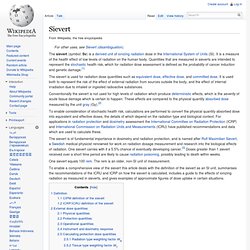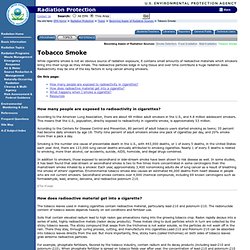

Background radiation. The weather station outside of the Atomic Testing Museum on a hot summer day.

Displayed background gamma radiation level is 9.8 μR/h (0.82 mSv/a) This is very close to the world average background radiation of 0.87 mSv/a from cosmic and terrestrial sources. Displays showing ambient radiation fields of 0.120-0.130 μSv/h (1.05-1.14 mSv/a) in a nuclear power plant. This reading includes natural background from cosmic and terrestrial sources, but excludes any contribution from contamination in the air, food, and water. Background radiation is the ubiquitous ionizing radiation that people on the planet Earth are exposed to, including natural and artificial sources. Both natural and artificial background radiation varies depending on location and altitude. Natural background radiation[edit] Average annual dosage from natural radiation varies by several mSv between different European countries.[4] Radioactive material is found throughout nature. Air[edit] Banana equivalent dose. A banana equivalent dose (abbreviated BED) is a unit of radiation exposure, defined as the additional dose a person will absorb from eating one banana.
The concept is based on the fact that bananas, like most organic materials, naturally contain a certain amount of radioactive isotopes—even in the absence of any contamination due to human nuclear endeavors. The banana equivalent dose was meant to express the severity of exposure to radiation, such as resulting from nuclear power, nuclear weapons or medical procedures, in terms that would make sense to most people. History[edit] The concept probably originated on the RadSafe nuclear safety mailing list in 1995,[original research?] Where a value of 9.82×10−8 sieverts or about 0.1 μSv was suggested for a 150 gram banana.[1] Relationship with standard units[edit] The major natural source of radioactivity in plant tissue is potassium, which in nature contains 0.0117% of the unstable isotope potassium-40 (40K).
Criticism[edit] See also[edit] Issue Brief: Radiological and Nuclear Detection Devices. "The U.S. government's quest to defend the nation against a smuggled nuclear weapon or radiological "dirty" bomb is approaching a crossroads.

"[1] The government arrived at a critical juncture in early 2006 and was forced to choose the path to take with respect to radiological and nuclear detection devices. The choice was either to keep the older monitors that were proven but did still have their problems, or to upgrade to the new generation of monitors, despite the cost and the fact that they are unproven. Their decision: to allocate billions of dollars in contracts to upgrade to a new and improved system. This paper will look into the need for radiological and nuclear detection devices, examine the current and proposed systems, and finally review the budget for the program. Introduction: Defining the Problem Since the attacks of September 11th 2001, there has been an ever increasing focus on protecting America and its people from terrorist attacks. Current monitors and future advances. Sievert. The sievert (symbol: Sv) is a derived unit of ionizing radiation dose in the International System of Units (SI).

It is a measure of the health effect of low levels of radiation on the human body. Quantities that are measured in sieverts are intended to represent the stochastic health risk, which for radiation dose assessment is defined as the probability of cancer induction and genetic damage.[1] To enable consideration of stochastic health risk, calculations are performed to convert the physical quantity absorbed dose into equivalent and effective doses, the details of which depend on the radiation type and biological context. For applications in radiation protection and dosimetry assessment the International Committee on Radiation Protection (ICRP) and International Commission on Radiation Units and Measurements (ICRU) have published recommendations and data which are used to calculate these. Radiation Protection. Becoming Aware of Radiation Sources: While cigarette smoke is not an obvious source of radiation exposure, it contains small amounts of radioactive materials which smokers bring into their lungs as they inhale.

The radioactive particles lodge in lung tissue and over time contribute a huge radiation dose. Radioactivity may be one of the key factors in lung cancer among smokers. On this page: How many people are exposed to radioactivity in cigarettes? According to the American Lung Association, there are about 48 million adult smokers in the U.S., and 4.8 million adolescent smokers. According to the Centers for Disease Control and Prevention, 80 percent of adult tobacco users started smoking as teens; 35 percent had become daily smokers by age 18.
Smoking is the number one cause of preventable death in the U.S., with 443,000 deaths, or 1 of every 5 deaths, in the United States each year. Top of page How does radioactive material get into a cigarette? What happens when I smoke a cigarette? Radiation Dosage Chart.